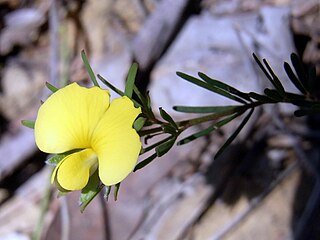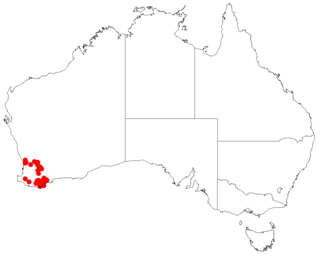
Olearia axillaris, commonly known as coastal daisy-bush, coast daisy-bush or coastal daisybush is a species of flowering plant in the family Asteraceae and is endemic to coastal areas of Australia. It is an erect, bushy shrub with densely cottony-hairy branchlets, aromatic, linear to narrowly elliptic or narrowly lance-shaped to egg-shaped leaves with the narrower end towards the base and small white and yellow, daisy-like inflorescences.

Olearia pimeleoides, commonly known as pimelea daisy-bush, is a species of flowering plant in the family Asteraceae and is endemic to southern continental Australia. It is an erect shrub with elliptic, linear or lance-shaped leaves, and white and pale yellow, daisy-like inflorescences.

Pomaderris intermedia, commonly known as lemon dogwood, is a species of flowering plant in the family Rhamnaceae and is endemic to south-eastern Australia. It is a shrub with hairy stems, elliptic to egg-shaped leaves, and clusters of yellow flowers.

Actinotus minor, commonly known as the lesser flannel flower, is species of flowering plant in the family Apiaceae and is endemic to New South Wales. It is a small, sprawling plant with grey-green leaves and white flowers.

Gompholobium glabratum, commonly known as dainty wedge-pea, is a species of flowering plant in the family Fabaceae and is endemic to south-eastern continental Australia. It is a low-lying or ascending shrub with pinnate leaves that have five to seven leaflets, and yellow and green or greyish flowers.

Persoonia trinervis is a species of flowering plant in the family Proteaceae and is endemic to the south-west of Western Australia. It is an erect, sometimes spreading shrub with densely hairy young branchlets, spatula-shaped or lance-shaped leaves with the narrower end towards the base, and densely hairy yellow flowers.

Amyema gaudichaudii, commonly known as melaleuca mistletoe, is a plant in the family Loranthaceae endemic to eastern Australia. Like other mistletoes, it is a shrubby, woody, aerial hemiparasite plant. It has relatively small, wedge-shaped leaves and small, dark red flowers arranged in groups of three. It only grows on a few species of Melaleuca.

Philotheca myoporoides subsp. myoporoides, commonly known as long-leaf wax flower, is a subspecies of flowering plant in the family Rutaceae and is endemic to south-eastern continental Australia. It is a shrub with oblong to elliptic or egg-shaped leaves and white or pink flowers arranged in groups of three to eight in leaf axils.

Pultenaea capitellata, commonly known as hard-head bush-pea, is a species of flowering plant in the family Fabaceae and is endemic to south-eastern continental Australia. It is a sprawling to prostrate shrub with elliptic to broadly egg-shaped leaves, and yellow to orange flowers with a red to purple keel.

Pultenaea euchila, commonly known as orange pultenaea, is a species of flowering plant in the family Fabaceae and is endemic to eastern Australia. It is an erect shrub with glabrous foliage, narrow egg-shaped leaves with the narrower end towards the base, and orange-coloured flowers arranged singly or in small groups near the ends of branchlets.

Podolobium scandens, commonly known as netted shaggy-pea, is a flowering plant in the family Fabaceae and is endemic to eastern Australia. It is a prostrate, small shrub with orange-yellow pea-like flowers and red markings.

Gompholobium virgatum, commonly known as leafy wedge pea, is a species of flowering plant in the family Fabaceae and is endemic to eastern Australia. It is an erect or sprawling shrub with trifoliate leaves, the leaflets narrow egg-shaped with the narrower end towards the base, and yellow and greenish, pea-like flowers.

Pomaderris ligustrina, commonly known as privet pomaderris, is a species of flowering plant in the family Rhamnaceae and is endemic to south-eastern continental Australia. It is a shrub with hairy stems, lance-shaped to narrowly elliptic leaves, and loose clusters of cream-coloured or yellow flowers.
Olearia chrysophylla is a species of flowering plant in the family Asteraceae and is endemic to eastern Australia. It is a shrub with scattered elliptic leaves, and white and yellow, daisy-like inflorescences.

Olearia cydoniifolia is a species of flowering plant in the family Asteraceae and is endemic to eastern Australia. It is a shrub with scattered elliptic leaves, and white and yellow, daisy-like inflorescences.

Epacris coriacea is a species of flowering plant in the heath family Ericaceae and is endemic to a eastern New South Wales. It is a slender, erect shrub with hairy branchlets, egg-shaped to more or less diamond-shaped leaves and tube-shaped, white or cream-coloured flowers.

Olearia quercifolia, commonly known as oak-leaved olearia, is a species of flowering plant in the family Asteraceae, and is endemic to the Blue Mountains in New South Wales. It is a shrub with elliptic to egg-shaped leaves with the narrower end towards the base, and white and yellow daisy flowers.

Olearia ramosissima, commonly known as much-branched daisy bush, is a species of flowering plant in the family Asteraceae and is endemic to continental Australia. It is a straggly shrub with densely-crowded, elliptic, egg-shaped or triangular leaves, and blue to violet and blue or yellow, daisy-like inflorescences.

Leucopogon cymbiformis is a flowering plant in the family Ericaceae and is endemic to the south-west of Western Australia. It is a bushy or wiry shrub that typically grows to a height of 30–50 cm (12–20 in) and has more or less glabrous branches. Its leaves are erect, linear to lance-shaped and sharply-pointed, mostly 2–4 mm (0.079–0.157 in) long. The flowers are arranged in short spikes, sometimes of only two or three flowers, with lance-shaped, leaf-like bracts, and bracteoles half as long as the sepals at the base of the spikes. The sepals are 2.5–3.0 mm (0.098–0.118 in) long and the petals slightly longer than the sepals, the lobes shorter than the petal tube.

Pimelea floribunda is a species of flowering plant in the family Thymelaeaceae and is endemic to the south-west of Western Australia. It is a shrub with narrowly elliptic to egg-shaped leaves arranged in opposite pairs, and drooping, head-like clusters of white or cream-coloured, tube-shaped flowers.



















